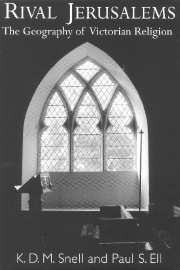Book contents
- Frontmatter
- Contents
- List of figures
- List of tables
- Preface and acknowledgements
- Introduction
- Part 1 Religious geographies: the districts of England and Wales
- 1 The 1851 Census of Religious Worship
- 2 The Church of England
- 3 Old dissent: the Presbyterians, Independents, Baptists, Quakers and Unitarians
- 4 The geographies of new dissent
- 5 Roman Catholicism and Irish immigration
- 6 Denominational co-existence, reciprocity or exclusion?
- Part 2 Religion and locality: parish-level explorations
- Technical appendices
- Bibliography
- Index
5 - Roman Catholicism and Irish immigration
Published online by Cambridge University Press: 08 August 2009
- Frontmatter
- Contents
- List of figures
- List of tables
- Preface and acknowledgements
- Introduction
- Part 1 Religious geographies: the districts of England and Wales
- 1 The 1851 Census of Religious Worship
- 2 The Church of England
- 3 Old dissent: the Presbyterians, Independents, Baptists, Quakers and Unitarians
- 4 The geographies of new dissent
- 5 Roman Catholicism and Irish immigration
- 6 Denominational co-existence, reciprocity or exclusion?
- Part 2 Religion and locality: parish-level explorations
- Technical appendices
- Bibliography
- Index
Summary
The presence of Roman Catholicism in the Religious Census is of particular interest, for the census was taken only six years after the onset of the Irish famine. Any account and mapping of the Catholic census data cannot but illuminate the tragic aftermath of that catastrophe, reflecting as it does much of the Irish diaspora in England and Wales that resulted. Cartographic analysis of the patterns of Catholicism from this source are among the ways in which post-famine settlement can be observed, a process of settlement that had a profound effect on regional cultures and religion in some parts of the British Isles. There had been earlier famines in Ireland, and there was a long history of Irish settlement in the towns and cities of England and Wales. Yet prior to the great famine of 1845–9 Irish migration had very often been short-term, or seasonal, working as harvesters, construction workers, in the armed forces and the like – particularly to arable, market-gardening or fruit-growing rural areas where the harvest earnings were high. The earnings enabled conacre and other rents to be paid in Ireland. After the famine however, this seasonal migration tended to decline and Irish migrants settled in a more permanent way. From the distressed regions particularly of western and southern Ireland, they came across the water to parishes of long-standing Catholic allegiance, occasionally to rural parishes, but much more often to the English textile and heavy industrial areas, and to districts of transport employment.
- Type
- Chapter
- Information
- Rival JerusalemsThe Geography of Victorian Religion, pp. 173 - 184Publisher: Cambridge University PressPrint publication year: 2000



